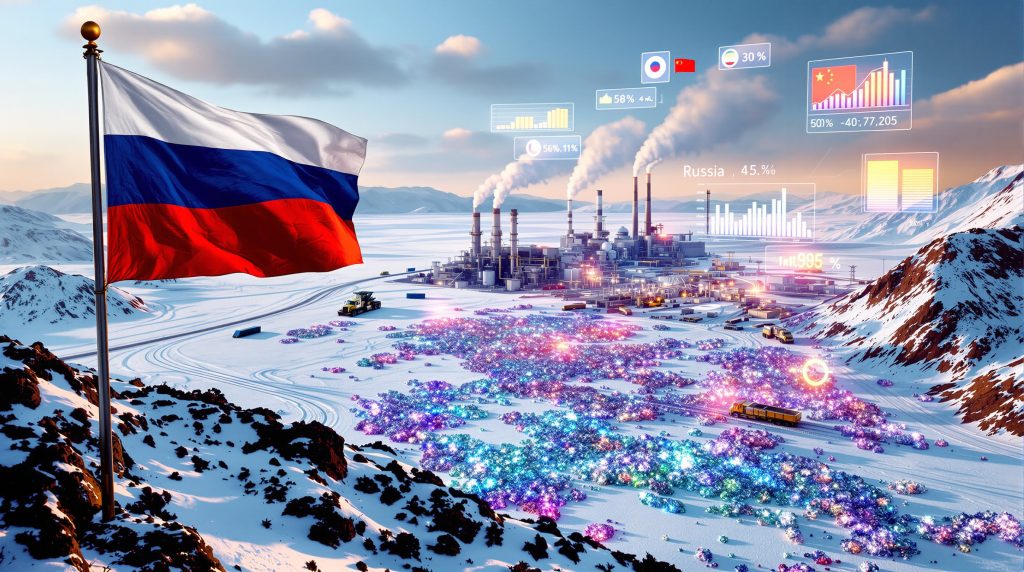Putin's rare earth extraction strategy represents a carefully orchestrated announcement that prioritizes political messaging over industrial substance. The December 1, 2025 directive emerged quietly through official Kremlin channels, instructing government ministers to develop comprehensive extraction plans within weeks rather than years. Furthermore, this timing coincides with broader geopolitical tensions where critical minerals energy transition discussions dominate international policy frameworks.
Understanding the Kremlin's December 2025 Mineral Directive
The directive's core components reveal significant gaps in implementation planning. No specific funding mechanisms accompany the ambitious timeline, while identified mineral deposits remain undefined within public documentation. This pattern mirrors previous announcements at Far Eastern Economic Forums since 2019, suggesting recycled policy statements rather than novel strategic initiatives.
Table: Key Components of Russia's Rare Earth Initiative
| Component | Details | Timeline |
|---|---|---|
| Extraction Roadmap | Comprehensive mining development plan | December 1, 2025 |
| Transport Infrastructure | Multimodal hubs with China/North Korea | 2025-2026 |
| Reserve Assessment | Disputed 3.8-28.7 million tonnes | Ongoing evaluation |
| Processing Capacity | Mid-stream separation facilities | Long-term development |
The emphasis on "multimodal transport hubs" at Chinese and North Korean borders indicates logistics prioritization over technological development. According to Reuters reporting, these transport corridors aim to connect Siberian resource extraction points with Asian processing facilities, creating sanctions-bypass architecture rather than independent industrial capacity.
How Do Russia's Rare Earth Reserves Compare Globally?
Russia's claimed reserves present a significant discrepancy that reveals the complexity of geopolitical mineral reporting. While Moscow's Natural Resources Ministry asserts control over 28.7 million tonnes across 15 rare earth elements, independent assessments paint a markedly different picture.
Comparative Reserve Analysis:
- Russian Government Claims: 28.7 million tonnes
- USGS Independent Assessment: 3.8 million tonnes
- Global Context: Represents 2% of worldwide known reserves
- China's Bayan Obo Complex: Processes more annually than Russia's decade-long extraction total
The ten-fold variance between official Russian claims and international geological surveys highlights the political dimensions of resource reporting in strategic minerals.
The substantial discrepancy between governmental declarations and USGS assessments reflects broader patterns in strategic mineral reporting where geopolitical considerations influence official reserve calculations. Independent geological surveys typically employ standardized methodology for resource estimation, while national government claims may incorporate politically-motivated categorizations or employ differing measurement standards.
China's Bayan Obo complex provides crucial context for understanding Russia's position within global supply frameworks. This Inner Mongolia facility represents one of the world's largest known rare earth deposits, producing substantial quantities of rare earth concentrates that feed Chinese separation facilities. The complex processes more rare earth material annually than Russia has extracted over the preceding decade, illustrating the scale differential between established operations and Russia's proposed development.
The reserve composition across 15 rare earth elements includes both light rare earth elements (LREE) and heavy rare earth elements (HREE), with significantly different market values and extraction complexities. However, public documentation lacks granular specifications regarding Russia's deposit composition, ore grades, or element distribution, limiting accurate commercial assessment.
What Infrastructure Challenges Face Russia's Rare Earth Ambitions?
Processing Bottlenecks Beyond Mining
The fundamental obstacle confronting Putin's rare earth extraction strategy extends far beyond mineral extraction capabilities. The nation lacks sophisticated mid-stream processing infrastructure essential for transforming raw ore into commercially viable products. Consequently, this mirrors challenges seen globally as mining industry innovation becomes increasingly critical for competitiveness.
Critical Processing Gaps:
- Separation Technology: Converting monazite sands to separated oxides
- Refining Capacity: Chemical processing for high-purity materials
- Magnet Production: Value-added manufacturing capabilities
- Quality Control: Meeting international specifications
China's Processing Dominance:
- 90%+ global rare earth separation capacity
- 95% worldwide magnet production
- Decades of technological development
- Integrated supply chain control
The technical transformation from raw ore concentrate to commercially viable separated rare earth oxides represents the economically significant value-addition stage requiring sophisticated chemical processing infrastructure. This process involves hydrochloric acid leaching of ore concentrates, solvent extraction procedures for individual rare earth element separation, and chemical precipitation systems for purification.
Russia's existing facilities operate using outdated Soviet-era chemical separation technologies that cannot achieve contemporary purity standards, throughput rates, or environmental compliance requirements. Complete facility modernization demands specialized equipment procurement, technical expertise acquisition, and environmental control system implementation—all constrained by current sanctions restrictions.
Soviet-Era Infrastructure Limitations:
- Equipment Obsolescence: Chemical processing machinery decades beyond replacement cycles
- Environmental Non-Compliance: Outdated pollution control systems
- Quality Standards: Inability to meet international material specifications
- Throughput Constraints: Limited production capacity relative to market demands
China's integrated advantage reflects accumulated technical expertise spanning decades, government policy support for supply chain consolidation, and access to international equipment suppliers prior to recent export restrictions. This technological foundation cannot be rapidly replicated under sanctions constraints without substantial capital investment and international cooperation.
How Do Sanctions Impact Russia's Rare Earth Development?
Western Partnership Impossibilities
Current geopolitical realities create insurmountable barriers for international collaboration in Russia's rare earth sector. Multiple layers of trade restrictions prevent meaningful Western engagement in Putin's rare earth extraction strategy. In addition, these constraints are exacerbated by ongoing US-China trade war impacts affecting global supply chains.
Sanctions Framework Obstacles:
- Financial Restrictions: Limited access to international capital markets
- Technology Transfer Bans: Prohibited equipment and expertise sharing
- Market Access Limitations: Restricted export destinations
- Joint Venture Prohibitions: Blocked partnership structures
The comprehensive sanctions architecture implemented post-February 2022 creates multi-layered barriers across financial, technological, and commercial dimensions. Russian companies cannot access international capital markets for financing facility construction or modernization, while Western financial institutions face civil penalties up to $20 million USD per violation under U.S. regulatory frameworks.
Equipment Procurement Impediments:
Specialized rare earth processing equipment manufactured primarily by German, Japanese, and American suppliers cannot be legally exported to Russia under Export Administration Regulations (EAR) and EU sanctions provisions. Chinese equipment alternatives exist but represent inferior technical specifications and require Chinese engineering oversight, creating technological dependence rather than independence.
Regulatory Compliance Requirements:
- U.S. Framework: Foreign Direct Product Rule restrictions and Specially Designated Nationals List prohibitions
- EU Framework: Dual-use goods export controls and financial transaction restrictions
- Penalties: Civil and criminal liability for sanctions violations
- Market Exclusion: Government contracting suspension for non-compliant companies
U.S. and European companies cannot legally finance, equip, or purchase Russian rare earth materials without violating comprehensive trade law frameworks.
The suggestion that Russia could partner with Western nations on rare earth development contradicts regulatory realities. Companies attempting such partnerships face mandatory licensing requirements from U.S. Commerce Department entities, civil litigation exposure, and exclusion from government procurement contracts.
What Role Do China and North Korea Play in Russia's Strategy?
Logistics Over Industrial Development
The December directive's emphasis on "multimodal transport hubs" at Chinese and North Korean borders reveals the true nature of Russia's approach—creating sanctions-bypass architecture rather than achieving technological independence. However, this approach differs significantly from recent Western initiatives such as Trump's critical minerals order focused on domestic capacity building.
Border Infrastructure Priorities:
- China Border Hubs: Enhanced rail and road connections
- North Korean Corridors: Alternative trade route development
- Siberian Integration: Resource corridor optimization
- Market Access: Asian destination facilitation
This logistics-focused approach deepens rather than reduces dependence on Chinese processing capabilities, contradicting narratives of strategic autonomy within Putin's rare earth extraction strategy.
China Border Integration Components:
The transport corridor development emphasises Trans-Siberian Railway connections to Chinese rail networks, road transport via Heilongjiang Province border crossings, and customs facilitation agreements specialised for bulk mineral transport. These infrastructure investments create buyer-dependent relationships where Russian companies extract and concentrate ore while Chinese enterprises perform value-added separation and manufacturing.
North Korean Transit Alternative:
Development of North Korean corridors provides redundancy to China-dependent routes while offering partial sanctions-bypass functionality. However, this approach introduces additional political risk considerations regarding UN sanctions regime applicability and administrative reliability for transit operations.
Strategic Dependency Model:
The proposed infrastructure creates a resource export pattern where:
- Russian Extraction: Mining and ore concentration within Russia
- Chinese Processing: Transport to Chinese separation facilities
- Integrated Manufacturing: Value-addition through Chinese supply chains
- Limited Value Capture: Russia retains primary extraction margins only
This model mirrors historical commodity export relationships where developing economies extract raw materials for processing by more technologically advanced nations, rather than building independent industrial capacity.
Why Are Russia's Rare Earth Promises Considered Political Theater?
Historical Pattern of Unfulfilled Commitments
Analysis of Russia's rare earth announcements reveals a consistent pattern of recycled promises without substantive implementation across multiple policy cycles. Furthermore, as reported by Al Jazeera, this latest directive follows familiar patterns of ambitious timelines without corresponding resource allocation.
Timeline of Repeated Commitments:
- 2019 Far Eastern Economic Forum: Initial rare earth development promises
- 2020-2023: Multiple restatements without funding allocation
- 2024: Continued rhetoric amid sanctions pressure
- 2025 December Directive: Latest iteration of identical commitments
Missing Elements in Current Directive:
- No new funding mechanisms
- Undefined deposit specifications
- Absent industrial partnerships
- Lack of technological roadmaps
The December 2025 directive contains language nearly identical to previous announcements at Far Eastern Economic Forums dating back to 2019, suggesting political recycling rather than policy advancement. Each iteration lacks specific budgetary allocations, defined mineral deposits, or identified industrial partnerships necessary for implementation.
Policy Recycling Indicators:
The current announcement mirrors previous commitments in structure, timeline, and scope without addressing fundamental obstacles identified in earlier implementation attempts. This pattern indicates political signalling designed for domestic and international audiences rather than industrial planning for capacity development.
Capacity vs. Rhetoric Gap:
Putin's rare earth extraction strategy promises technological sovereignty while simultaneously emphasising transport infrastructure to Chinese processing facilities. This contradiction reveals the directive's function as geopolitical positioning rather than industrial transformation planning.
What Are the Investment Implications for Rare Earth Markets?
Market Reality Versus Political Messaging
For investors analysing rare earth sector opportunities, Russia's latest directive represents political signalling rather than material market impact on global supply chain dynamics. In contrast, established initiatives like the European CRM facility offer more concrete development pathways.
Investment Considerations:
Potential Speculative Impact:
- Short-term interest in Arctic-focused junior miners
- Political risk premium adjustments
- Sanctions compliance evaluation requirements
Fundamental Market Realities:
- No near-term production capacity additions
- Continued Chinese processing dominance
- Western supply chain diversification imperatives unchanged
Russia's rare earth ambitions may generate speculative interest but lack the capital, technology, and market access necessary for meaningful production increases.
Speculative Trading Opportunities:
Junior mining companies with Arctic rare earth exposure may experience short-term share price volatility based on political announcements rather than operational developments. However, fundamental analysis reveals absent funding mechanisms, undefined deposit specifications, and processing infrastructure gaps that prevent meaningful production increases.
Market Psychology Factors:
Investor sentiment regarding Russian rare earth development often reflects geopolitical tensions rather than industrial capacity assessment. Putin's rare earth extraction strategy generates headlines that can influence speculative trading without corresponding operational substance.
Long-Term Strategic Implications:
Western supply chain diversification initiatives remain unaffected by Russian announcements due to sanctions restrictions preventing meaningful partnership opportunities. Alternative supply development through Australian processing expansion, North American mining acceleration, and recycling technology advancement continues as primary diversification strategy.
How Does This Strategy Affect Global Supply Chain Security?
Self-Reliance Imperatives for Western Nations
Russia's rare earth initiative, regardless of its practical limitations, reinforces the strategic importance of supply chain independence for Western economies and their allies.
Strategic Implications:
- Diversification Urgency: Accelerated development of non-Chinese sources
- Technology Investment: Enhanced processing capability development
- Alliance Building: Strengthened partnerships with reliable suppliers
- Stockpiling Strategies: Strategic reserve accumulation
Alternative Supply Development:
- Australian processing expansion
- North American mining acceleration
- African resource development
- Recycling technology advancement
The geopolitical dimensions of Putin's rare earth extraction strategy emphasise supply chain vulnerability for nations dependent on Chinese processing dominance. While Russian production capacity remains limited, the announcement reinforces strategic mineral supply security as national security priority.
Western Response Mechanisms:
Recent legislative initiatives including the U.S. CHIPS Act and EU Critical Raw Materials Act reflect recognition that strategic mineral independence requires domestic processing capability development rather than alternative extraction source identification alone.
Allied Partnership Development:
Japan, Australia, Canada, and European Union nations continue expanding rare earth processing partnerships that bypass both Chinese and Russian supply chains. These initiatives focus on integrated supply chain development from mining through magnet manufacturing.
Strategic Reserve Policies:
Government stockpiling programmes for critical rare earth materials provide supply security buffers while domestic processing capabilities develop. These reserves offer market stability during geopolitical supply disruptions.
What Technical Hurdles Must Russia Overcome?
Soviet-Era Infrastructure Obsolescence
Russia's rare earth processing capabilities remain anchored to outdated Soviet-era facilities that cannot meet modern quality and efficiency standards required for international market competitiveness.
Technical Modernisation Requirements:
- Equipment Replacement: Complete facility overhauls needed
- Environmental Compliance: Modern pollution control systems
- Quality Standards: International specification achievement
- Skilled Workforce: Specialised technical training programmes
Under-Sanctions Development Challenges:
- Limited access to advanced processing equipment
- Restricted technology transfer opportunities
- Isolated research and development efforts
- Reduced international technical collaboration
Processing Stage Technical Requirements:
Stage 1 – Extraction Infrastructure:
- Modern mining equipment for ore concentration
- Beneficiation systems achieving 15-65% rare earth oxide content
- Transportation infrastructure for bulk material movement
- Environmental remediation systems for mining waste
Stage 2 – Separation Facility Modernisation:
- Hydrochloric acid leaching systems with environmental controls
- Solvent extraction columns for individual element separation
- Chemical precipitation and purification equipment
- Quality assurance testing laboratories meeting international standards
Stage 3 – Downstream Manufacturing:
- Metallothermic reduction facilities for oxide-to-metal conversion
- Specialised alloy manufacturing equipment
- Rare earth magnet production capabilities including sintering and coating systems
- Final product certification processes
Workforce Development Challenges:
Putin's rare earth extraction strategy requires specialised technical expertise spanning metallurgical engineering, chemical processing, and environmental compliance disciplines. Soviet-era training programmes lack contemporary technical focus while sanctions restrictions limit international knowledge exchange opportunities.
Environmental Compliance Obstacles:
Modern rare earth processing demands sophisticated environmental control systems for acid waste handling, air emission filtration, and groundwater protection. Russian facilities require comprehensive environmental infrastructure modernisation to meet international operational standards.
Conclusion: Rhetoric Versus Industrial Reality
Russia's December 2025 rare earth extraction directive represents political positioning rather than industrial transformation within global supply chain frameworks. While Putin's rare earth extraction strategy may generate short-term market speculation, fundamental obstacles prevent meaningful contribution to global supply diversification.
Implementation Barriers Summary:
- Limited Reserves: USGS assessment indicates 3.8 million tonnes versus Russian claims of 28.7 million tonnes
- Processing Infrastructure Gaps: Absence of modern separation and refining capabilities
- Sanctions Restrictions: Prohibited Western technology transfer and financing
- Technological Isolation: Reduced international collaboration opportunities
Strategic Implications for Western Nations:
The directive reinforces rather than reduces the imperative for supply chain independence through alternative sources, processing capabilities, and strategic partnerships outside sanctioned jurisdictions. Russia's rare earth strategy, despite ambitious rhetoric, cannot provide reliable supply chain diversification that modern economies demand.
Investment Reality Assessment:
Putin's rare earth extraction strategy functions as geopolitical signalling rather than industrial capacity development. Fundamental constraints including capital limitations, technology restrictions, and market access barriers prevent transformation of political announcements into operational rare earth production increases.
For Western nations and their allies, sustainable rare earth security requires continued investment in alternative sources, processing infrastructure development, and strategic partnerships with reliable suppliers. Russia's rare earth initiative, regardless of its stated ambitions, cannot substitute for comprehensive supply chain diversification strategies that prioritise technological independence and geopolitical stability.
Disclaimer: This analysis contains forward-looking statements and geopolitical assessments that involve inherent uncertainties. Investment decisions should consider comprehensive risk factors including regulatory changes, technological developments, and international relations dynamics. Rare earth market developments involve speculative elements that may not align with political announcements or strategic directives.
Looking to Navigate the Rare Earth Investment Landscape?
Discovery Alert's proprietary Discovery IQ model delivers real-time alerts on significant ASX mineral discoveries, helping investors identify actionable opportunities in critical minerals and strategic commodities ahead of the broader market. Explore Discovery Alert's dedicated discoveries page to understand why historic mineral discoveries have generated substantial returns, then begin your 30-day free trial today to position yourself ahead of geopolitical supply chain disruptions.




